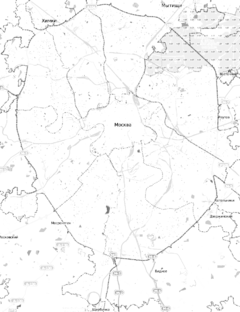Kuzminki (Moscow Metro)
Kuzminki (Russian: Кузьминки) is a station on Moscow Metro's Tagansko-Krasnopresnenskaya Line. The station was opened on 31 December 1966 as part of the Zhdanovsky radius and is named after the Kuzminki District in southeastern Moscow where it is situated.
Overview
The station has two underground vestibules interlinked with subways under the Vologradskiy avenue with access to Zelenodolskaya, Marshala Chuikova and Zhigulevskaya streets with light glazed pavilions on the surface. Up to Kuzminki the Line has followed the Volgogradskiy Avenue to the southeast. However afterwards the line turns perpendicular and adjoins the parallel Ryazanskiy avenue and then follows it. As a result, the station has quite a high passenger traffic due to lots of public transport arriving from the southeastern suburban towns which in March 2002 totalled 116,100 passengers daily.
In the very distant future it is likely that the track between Ryazanskiy Prospekt and Kuzminki will be closed and the Taganskiy radius will continue along the Volgogradskiy avenue into the adjacent Moscow towns of Lyubertsy and even as far as the Bykovo airport.
Design
The station is a typical pillar-trispan design of the 1960s with a modest theme (architects L.A. Shagurina and M.N.Korneeva) of white marbled pillars and creme and red coloured ceramic tiles on the walls, which are also decorated with cast bariliefs that contain images of forest animals (artist G.G. Derviz). The floor is covered with grey and red granite.
_(5064599540).jpg)
External links
- metro.ru
- mymetro.ru
- KartaMetro.info — Station location and exits on Moscow map (English/Russian)
_(5063984835).jpg)

